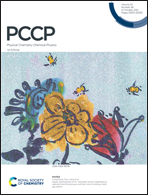Direct aryl–aryl coupling of pentacene on Au(110)†
Abstract
Selective C–H bond activation of polycyclic aromatic hydrocarbons is challenging due to the relatively high bond dissociation energy and the existence of multiple equivalent C–H sites. Herein, we report a scanning tunneling microscopy study on the covalent coupling of pentacene molecules on Au(110) surfaces. The missing-row reconstruction of Au(110) surfaces strengthens the molecule–substrate interactions. At elevated temperatures (470–520 K), pentacenes undergo direct aryl–aryl coupling via C–H bond activation. Due to the anisotropic feature of the reconstructed Au(110) surface, pentacenes are preferentially oriented parallel or perpendicular, making the linear and T-shaped dimers the predominant products. Based on density functional theory calculations, the aryl C–H bond activation barrier is reduced to 1.42 eV on Au(110)-(1 × 3) reconstructed surfaces, at which the extra row of gold atoms located in the (1 × 3) reconstructed grooves plays a key role.



 Please wait while we load your content...
Please wait while we load your content...